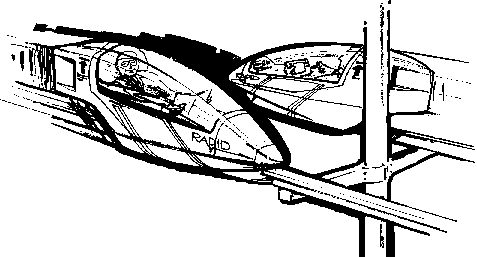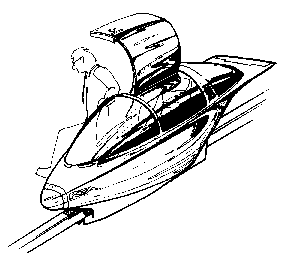SkyTran ESSENTIAL Requirements
In order to obtain all of the economic, pollution, speed and safety benefits that a Personal/Mass transportation system like the SkyTran System concept offers, certain requirements absolutely must be met.
1. It must be MagLev. Anything other than a pure solid state transportation system will be an expensive maintenance nightmare forever. This is all about long term costs and NOT burdening all taxpayers just to benefit a few.
One example would be maintenance costs for an alternative wheeled vehicle. If an individual SkyTran vehicle is in full use 10 hours each day, the vehicle would accumulate 100,000 miles in just 100 days (roughly 3 months). Think about the cost of replacing 60,000 mile rated full size automobile tires every 2 months and you'll understand why a non-contact pure SOLID STATE transportation system is absolutely essential!2. It must be small and light. A heavier SkyTran vehicle (to say carry more people) means the track must be beefier. If you do that, the all important minimum track costs will go up accordingly. For a given budget, this means LESS track can be built and LESS people will have conveniently close access to low cost, high speed commuting. Our goal is to provide super low cost high speed commuting for the majority. This probably means only 98% benefit. I cannot carry 500 pound people and not severely penalize the majority. It is essential to hit the $1 million per mile target (or better). The robot trackformer and intended use of existing semi-automated light pole placing equipment technology requires the kinds of gross weights we are talking about.
3. It must be streamlined. A low aerodynamic drag shape factor combined with minimum reasonable frontal area means less energy wasted disturbing the air. At 100 MPH we can greatly reduce power costs and directly daily costs to the users by paying strong attention to the drag of the Vehicle. This means comfortable sports car like reclined seating rather than full upright seating. Also, the MagLev power system inside the roll formed track must be very small relative to the available cross section area and also be streamlined. We absolutely do not want to consume excess power trying to push a near sealed "piston" through the tube.
For the above aerodynamic reasons, the optimum design for the majority, will not comfortably fit 7' 6" basketball players. It will be far cheaper overall to just provide absolutely free door-to-door chauffeured limousine service to these rare exceptions (and the above 500 pound people), than to design and build a degraded, less efficient, more expensive system to try to accommodate all variants in humanity. (We, also, have great ideas for handling wheelchair bound, handicapped people - It's different and surely won't comply with ADA laws, but they will love it! And laws made by humans can always be changed! The handicapped will be the ones spearheading this change! It will take a couple of future pages to fully describe it. Those pages should be added in about 1.5 months. Come back to the Web Site then.)4. It must be above ground. This is the only way to totally eliminate the possibility of collisions with cars, trucks, pedestrians and animals. To be safe, just make it impossible to crash with those items. Tunnels, as an alternative, cost way too much to build per mile and are visually depressing to drive in for long distances. Besides, underground you will probably still find great big, disease carrying, ugly rats to smash into and splatter - which nowadays means big trouble with the government rat lovers.
5. Exiting or merging onto the main track must be passive. Exit lanes and merging lanes absolutely cannot be mechanical devices like the switches used since the 1800's on railways. A mechanical switch that could: extend; allow one vehicle to switch; and fully retract in 1/2 second before the next vehicle is passing that point would be a horrible expensive maintenance nightmare - forever. Exiting and merging must be like a freeway road. The exit and its off-ramp are simple permanent structures. You just issue commands (steer) whenever you are ready to exit. (Magnetic vehicle exit lanes and merging lanes were tested and proven by the Aerospace Company in the 70's and should do fine.)
6. The vehicles must be mechanically trapped into the hollow track. Trains riding on top of two tracks occasionally derail and kill people. The answer is to make derailment impossible. Enhance human safety by technically eliminating an entire group of accident possibilities.
7. The vehicles must hang below the hollow track. Structural reinforcement (and associated extra costs) needed to support twisting loads into the track from going around a corner (centrifugal accelerations) and/or from side wind loads can all but be eliminated by changing the vehicles from riding on top of the roll formed track to hanging from below (see earlier color photos).
A good analogy is the hanging Batman roller coaster ride at Magic Mountain with a left/right freely swinging pivot hinge at the top. The weight and side load vectors naturally bank the vehicle so no bending goes into the support structure above. Also, this makes for a more comfortable ride because the passenger is automatically banked and is never thrown against the outside walls during high speed turns
From the beginning (back when Larry Wood create the following concept drawings) we knew that supporting the SkyTran vehicles from above would be superior from a structural standpoint. It took finally figuring out how to cleverly get older, frail people in and out of a hanging SkyTran vehicle very simply and easily to make that tradeoff wonderfully acceptable. No pictures of that until we get a new patent complete. Figure out a good way yourself!
This is the earliest concepts for the SkyTran vehicles. They rode on top of a "T-shaped" track and were trapped to the track so they could never derail. (Look at the dinky track. You can easy visualize a large side wind on the Vehicle twisting the heck out of it.
This is another of Larry Wood's super drawings of the early concept. To exit, the passenger must stand up out of his reclined seat, then step over an 8" tall structural stiffener (just like exiting most automobiles).
WE love working with Larry (who is the "Mr. Hot Wheels" designer at Mattel for a couple of decades now). He freely admits he doesn't know anything about structural engineering and says such technical details are entirely my problems - He's just "stylin" cool looking ideas. (Take another look at Larry's Track Forming Robot drawing and ask whether or not it would tear down the the cross braces as it passes underneath? It would! Easy fix - think about it!)
Larry is a welcome relief from a lot of other former LA Art Center of Design students - who have had one course in structures and one in aerodynamics and somehow have been brainwashed that they are now "official" experts in both fields. Drives me nuts!8. The Vehicles must be computer controlled. However, there need not be a monster, master computer controlling each and every SkyTran vehicle simultaneously at all times. Each SkyTran vehicle has its own individual small computer and intelligence. When it is ready to leave the station and merge into traffic, it checks for upcoming openings, then accelerates under precise controlled conditions to merge in with 1/4" accuracy. If the computer senses that the "velocity buildup profile" is somewhat slower than desired (say two 200 pound passengers are on board), the Vehicle computer instantly delivers more current from the track to speed it up. If accelerating slightly fast (say one light teenage passenger or it's empty), the Vehicle computer compensates by feeding slightly less propulsion current. Such adjustments will happen 1,000 times per second. Such precision merging with today's modern computers is simple, cheap and enhances the total safety concept.
9. The SkyTran system should not need to pay for any Rights-of-Way. First of all, even though a simple SkyTran track pair can carry as many people per hour as a six lane freeway, it is NOT a toll road/freeway that requires cutting miles long 300 to 400 foot wide swaths through neighborhoods. All a SkyTran line needs is a series of two foot diameter buried foundations to support exposed 10" diameter vertical steel tubes. These can be placed anywhere, without having to mow down any homes or grossly deface the existing landscape.
BUT aren't SkyTran vehicles disgusting visual pollution? It is all relative. We all grew up with the sight of paved roads all around us and so accept that as "Normal". (Think about it - Roads and parking lots are yucky visual pollution. We simply deem them necessary for functional living and accept them as is. I'd rather see trees and green grass, how about you?) If you had to make a choice between a new six lane freeway built next to your house/neighborhood OR a two track SkyTran system suspended from one row of poles (a system which handles just as many commuters per hour as the freeway) which would you choose? We think most people would take the option that is not much different visually than old fashioned telephone poles with wires strung between them. Something like the SkyTran system proposed here may simply become the normal sight of futuristic cities?
10. The system must be three-dimensional. Intersections in two-dimensional space means traffic lights, continual stopping and starting, and the inevitable crashes. The extra costs to totally eliminate this kind of potential accident by having North-South Vehicles traveling at one height and East-West Vehicles crossing over at a different height is minimal. Also, continuous steady speed is very important to trip time AND for minimum energy usage.
11. The departure/arrival stations can not be "stations". Think low cost or no cost bus stops, instead. No buildings. No ticket takers. No attendants. People do not need to have nice (read expensive) buildings to be protected from the weather while waiting for a scheduled bus or train to depart - IF there is never any waiting! Get in one and GO!
12. There must be an extra power source onboard for emergencies. In the event a total electrical grid power failure occurs, I do not want all the people to be stuck sitting for hours 15 or 20 feet in the air! What can we do that makes sense?
The cost of a continuous emergency walkway with hand rails would totally kill the concept of low cost per mile. Perhaps we could include something like a built-in emergency cable lowering system to get the Vehicles down to the ground? Don't care for that, either! What if the main power came back on when you were half way down? OW!
How about simply providing an onboard emergency power source that could keep the machine going for at least three more miles at 100 MPH. When, the computer senses main power total dropout, it kicks in automatically in a couple of milliseconds and takes over (just like a computer UPS). The only thing you notice is a blinking red light which tells you - whether you like it or not - that your machine will be exiting and stopping at the next station. It takes about 14 pounds of old fashioned lead acid type battery to do that job (less weight if we use the high power for 3 minute NiCads as used on WRPA's White Lightning ).
Adhering to the above basic requirements is absolutely essential - but only if we want to provide all commuters with non-stop 100 MPH speeds at low costs, and with greatly enhanced safety!

